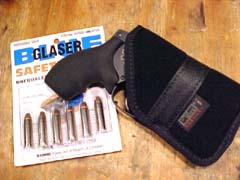|
The Smith
& Wesson J-frame .38 Special has been around for over
fifty years now in its original "Chief’s Special"
configuration. Since then, S&W has added many variations of
the original, but the J-frame line of thirty-eights is still the
standard to which all other small frame revolvers are compared.
We recently
received at Gunblast.com for testing one of Smith’s latest
renditions of their venerable pocket thirty-eight; the model
342PD Centennial. The Centennial revolvers have a true concealed
hammer design, allowing double-action-only fire. For a self
defense gun of this size, the double-action-only system works
just fine. As with any self defense handgun, it is meant to be
carried comfortably concealed, and hopefully never used against
an attacker. In the event that it is necessary to use the gun in
defense of one’s life, the double-action-only system of fire
works very well indeed.
There are
three major advantages to the Centennial concealed hammer
design. First, this design results in a revolver that is as
snag-proof as a pocket revolver can be. There is no hammer spur
protruding from the top of the gun to hook itself into clothing
while drawing the weapon from pocket or holster. Second, the
frame and side plate are raised in profile at the back just
above the grip to conceal the hammer, resulting in a hump that
is very beneficial in controlling the weapon during recoil. It
prevents the gun from rocking upward in the hand under the
recoil of heavy +P loads, allowing a faster rate of fire and
eliminating hammer bite. Third, the Centennial design prevents
lint, dirt, and other crud from getting into the inner workings
of the gun around the hammer. In a pocket revolver, this latter
feature is very important. A gun carried for self defense has to
work when needed, every time. If the action is full of debris,
the function can be greatly impaired. Drawing a weapon that
doesn’t work could be very embarrassing at best, and even
detrimental to one’s health and well-being. These three
features of the Centennial design make it, in my opinion,
the best of the J-frame thirty-eights.
The S&W
342PD is the lightest of the Centennial series, weighing a
feathery 10.8 ounces. Smith & Wesson has pioneered the use
of titanium alloys in its revolvers, resulting in weapons that
are much easier to carry concealed, without sacrificing
strength. Titanium, when compared to steel, is lighter, tougher,
and absolutely rust-proof. The 342PD is over four ounces
lighter than the aluminum-frame/steel cylinder 442, and
three-quarters of a pound lighter than the stainless steel
model 640. In a pocket gun, every ounce counts, and the 342PD is
the lightest concealed-hammer .38 Special revolver you can buy.
Only the S&W 337PD exposed-hammer Chief’s Special is
lighter, by one-tenth of an ounce.
The 342PD has
a handsome two-tone finish, with the aluminum frame, barrel
shroud, and cylinder yoke finished in a matte black, and the
titanium cylinder and stainless barrel liner in a dull gray. The
barrel / cylinder gap on this revolver is very even and tight
for a revolver of this type, measuring only three
one-thousandths of an inch.
The 342PD has
a fixed notch rear sight with a highly visible red insert in the
ramp front. These sights are just about perfect for a snub-nose
revolver, and are absolutely snag proof. The trigger is
five-sixteenths of an inch wide and smoothly finished on its
surface, resulting in a trigger pull that feels lighter than the
ten and one-half pound measured pull weight. The feel of the
action, in typical Smith & Wesson style, is buttery smooth.
The trigger is within easy reach of even a small hand, but the
excellent Hogue Bantam synthetic grip feels great in my
large sized, fat-fingered left hand. The ejector rod on
the 342PD is protected by the barrel shroud, and provides a
five-eighths of an inch ejection stroke. The top of the frame,
bottom of the trigger guard, and back strap of the grip frame
have been relieved of excess metal for further weight savings.
The 342PD has
Smith & Wesson’s internal locking system. This
key-activated system blocks the movement of the hammer and
trigger, but the cylinder can still be opened for loading and
unloading of the gun. The S&W locking system is
unobtrusive and easy to use, requiring only that the key be
inserted above the cylinder release and turned counterclockwise
to lock, and clockwise to unlock. While I think that no safety
device can substitute for proper training, this feature could be
useful in the event that the gun, when stored, could possibly
find its way into untrained hands. The 342PD came supplied with
two keys for the internal locking system, a trigger lock with
two keys, and a locking hard case.
Testing of the
342PD consisted of firing as many different types of .38 Special
ammo as I could find; from cast bullet hand loads, to factory +P
hollow points, and high performance specialty ammunition. All
ammo tested worked perfectly in the little Smith, with no
failures of any kind. Accuracy of the 342PD was very good for a
lightweight revolver with a one and seven-eighths inch barrel.
While a snub nosed revolver can be as intrinsically accurate as
a long barreled one, the combination of light weight and a short
sight radius make the snub nose harder to hit with for most
shooters. All ammo tested grouped under three inches at
twenty-five yards, which is decent combat accuracy. I also tried
the little five-shooter against some steel javelina silhouette
targets at a range of forty yards, with surprisingly satisfying
results. I was able to ring the steel more often than not,
with the +P ammo toppling the little pigs with ease. In the
lightweight 342PD the recoil is noticeable, but due to the grip
shape and the excellent Hogue Bantams, the gun is quite
manageable.
I was very
impressed by one type of specialty high performance
ammo in particular: that being the Glaser Safety Slug.
The Glaser has been around since the mid-1970s, and has
benefited from several improvements since that time. The Glaser
has a pre-fragmented core of compressed number twelve shot (a
core of number six shot is also available), capped by a soft
plastic ball, inside a bullet jacket. The Glaser Safety Slug
tested uses an eighty grain bullet rated at +P velocity and
pressure, and chronographed at an average of 1268
feet-per-second from the short one and seven-eighths inch barrel
of the Smith. The idea behind the Glaser is a slug that will
dump all of its energy quickly into the target, without
excessive penetration of the target. As can be seen in the
photos, the terminal results on a large ripe watermelon were
very impressive. While a watermelon bears little
resemblance to flesh and bone, it does demonstrate the relative
effects of a high velocity projectile which dumps all of its
energy into the target. The interior of the watermelon was
pulverized as if hit by a high velocity rifle bullet, with
pieces and pulp scattered over an area of about eighteen feet.
The performance of the Glaser has been proven in ballistic
gelatin and on human flesh, and I think that it is the cartridge
of choice in a small .38 revolver. In the +P rated 342PD, the
Glaser shot to point-of-aim, with very good accuracy. The round
offers high velocity, good accuracy, and a low chance of
penetrating the target and hurting someone else, along with
exceptional terminal performance. While the Glaser Safety Slug
is not cheap, how much is your life worth?
For a couple
of months I have been carrying the 342PD around, usually in my
front left-hand jeans pocket. It rides there very comfortably in
an Uncle Mike’s pocket holster, or sometimes dropped
into the pocket without the holster. Due to the five shot
cylinder, the gun is relatively thin and doesn’t print at all,
as can be seen in the accompanying photo. In the picture,
the gun is in my left-hand pocket within easy reach of my hand;
loaded and ready, but out of the way. This is the best way
to carry a gun while wearing jeans and a tucked-in tee shirt.
While wearing a coat or light jacket, the 342PD rides
unnoticeably in a front side pocket. A person can place his hand
on the gun without drawing unwanted attention, yet be able to
fire immediately if necessary, even through the pocket without
the gun jamming, as could an autoloader or exposed-hammer
revolver.
The
lightweight J-frame is a good compromise between
portability and power, and the 342PD is the best of the J-frames
to carry for self defense. Carried with a payload of five
Glasers, you have a dependable, powerful, and lightweight
package that can always be with you, instead of a larger weapon
that may be left at home. Remember, the first rule of winning a
gunfight is to have a gun. The 342PD is a gun that can be at
hand when needed, yet powerful enough to get the job done.
Check out the
full line of Smith & Wesson products online at:
www.smith-wesson.com.
For more
information on the Glaser ammunition, go to www.safetyslug.com.
Jeff Quinn
  
Got something to say about this article? Want to agree (or
disagree) with it? Click the following link to go to the GUNBlast Feedback Page.
All content © 2002 GunBlast.com.
All rights reserved. |
|
Click pictures for a larger version.

Smith & Wesson's J-Frame Model 342PD comes with a
fitted, lockable case, trigger lock, and two keys for
S&W's internal locking system.

Author demonstrates the handy size of the S&W Model
342PD.

Titanium 5-shot cylinder of the S&W Model 342PD.

S&W's internal key-locking system blocks hammer
& trigger movement but allows cylinder to be opened.

The Model 342PD features a very effective red ramp front
sight, along with a fixed rear notch. These sights can be
improved upon with an aftermarket "night sight" such
as XS Sight Systems' "Big
Dot" Tritium Night Sight.

The S&W Model 342PD sports Hogue's excellent Bantam
grips and a lanyard pin.

Carried in an Uncle Mike's pocket holster and stoked
with the great Glaser Safety Slugs, the Model 342PD is a
potent pocketful of power.

The S&W Model 342PD rides unnoticed in Jeff's
left-hand front pants pocket, within easy reach of the
Southpaw Scribe.

Author, with his hand on the Model 342PD in his left
jacket pocket, is ready for casual or deadly human
interaction.

The S&W Model 342PD, shown with a cylinder full of
Glaser Safety Slugs. Author found the excellent Glasers shoot
perfectly to point of aim in his Model 342PD.

The destructive power of the Glaser +P load is shown on
a ripe melon from Jeff's garden.
|
![]()